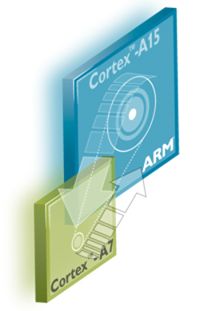
A new chip from a British company looks set to bring smartphone prices tumbling down to below £60 within a couple of years, and also promises up to five times greater battery life.
Cambridge-based ARM, which supplies technology to the majority of mobile and tablet manufacturers, has announced its Cortex-A7 MPCore processor, which not only delivers five times the energy-efficiency of its already low-poer Cortex-A8, but is also just a firth of the size.
And by combining this processor with the company's high-performance Cortex-A15 in what the company calls Big.LITTLE processing, switching between the two seamlessly and dynamically, ARM manages to satisfy demand for both performance and low power consumption.
It has already signed up a number of mobile telecoms manufacturers for this technology, including Broadcom, Compal, Freescale, HiSilicon, LG Electronics, Linaro, OK Labs, QNX, Redbend, Samsung, Sprint, ST-Ericsson and Texas Instruments.
Another prominent user of ARM's technology, Apple, has not yet confirmed whether or not it's onboard.
ARM says that the new Cortex-A7 processor occupies less than 0.5sq mm inside a phone, and when used as standalone processor will offer sub-$100 smartphones by 2013-14 with performance comparable to today's $500 models.
It sees that as a vital move for in the developing world, where it will help 'connect the next billion people to Internet content and services over mobile devices.'
That could be crucial given a report published today by market research company In-Stat, which says unit shipments for low-cost smartphones will be around 340m in 2015. In-Stat defines 'low-cost' as models selling for $150 or less – a target ARM suggests could easily be met with phones running its new processor.

Big.LITTLE
But going beyond the smaller, lighter, cheaper promise, ARM's Big.LITTLE processing offers the prospect of greater performance along with much more efficient battery use.
It does this by combining the two different processors within the same System on Chip, and allowing power management software to select the appropriate processor, or combination of processors for the task at hand.
Thus the LITTLE processor – the lower-power device, in this case the Cortex-A7 – would run the phone's operating system and 'always-on, always connected' tasks, such as social media and audio.
When processor-intensive tasks or apps are required, such as navigation or gaming, the phone would migrate the OS and apps to the high-performance device, this taking just 20ms to achieve.
As a result the software and apps just run seamlessly, with the user unaware of the processor switching going on 'behind the scenes'.
A virtual platform for development of phones running Big.LITTLE, using the Cortex-A7 and Cortex-A15 as well as the tools required to integrate them, is already being made available to ARM's leading partners.
